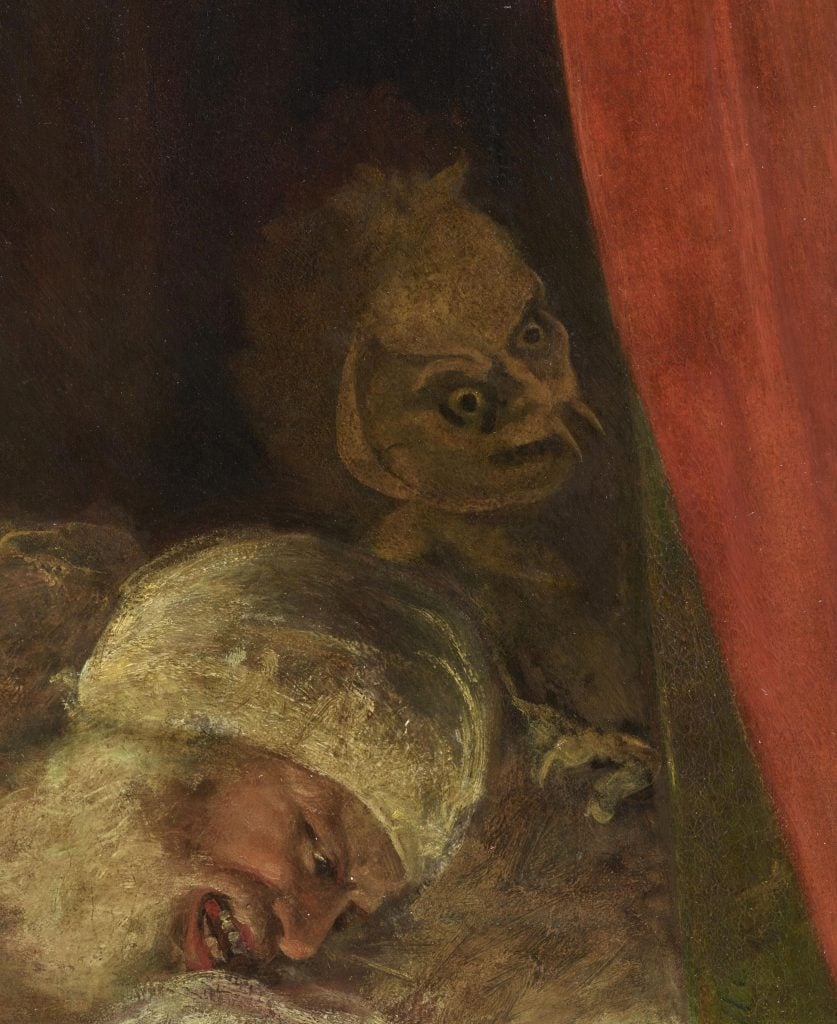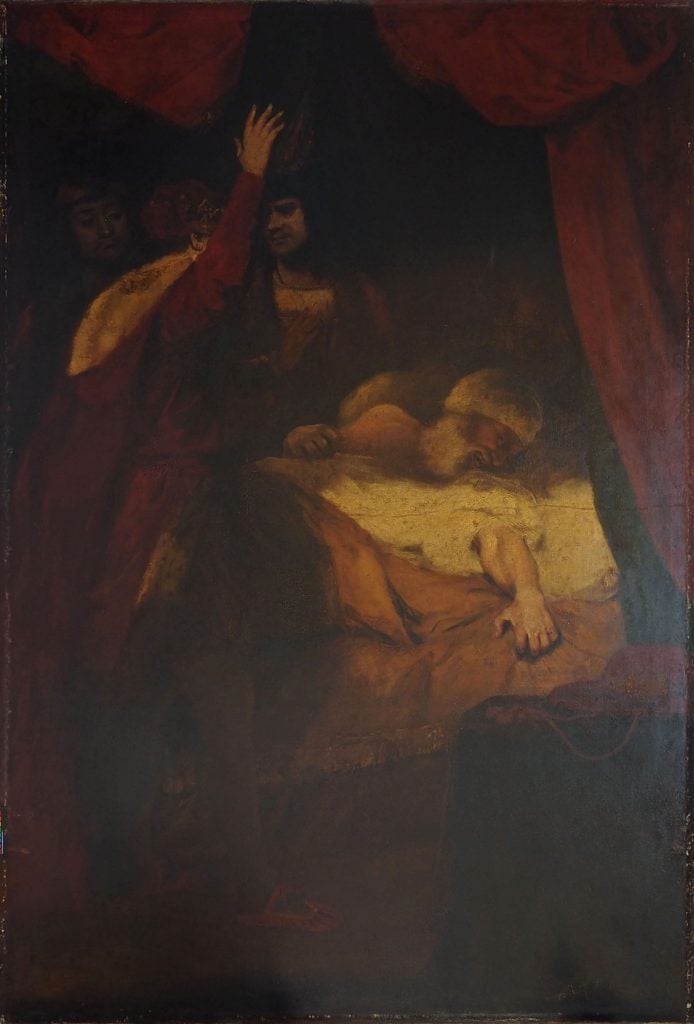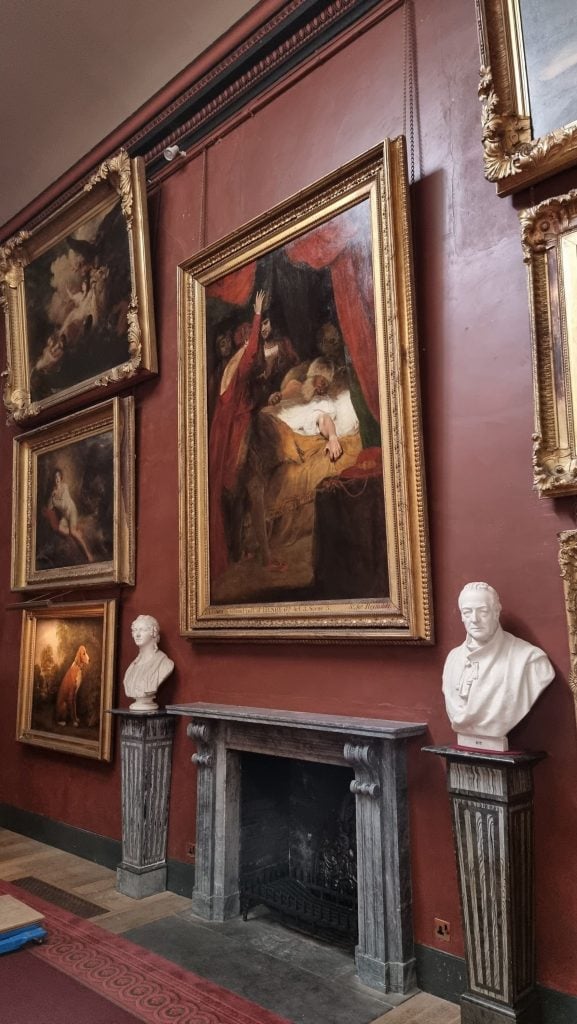Art History
Conservators Find a ‘Monstrous Figure’ Hidden in an 18th-Century Joshua Reynolds Painting
The creature was found hidden under layers of paint and varnish.

The creature was found hidden under layers of paint and varnish.

Artnet News

The devil, it seems, is quite literally in the details of an 18th-century Joshua Reynolds painting. Recent conservation work on the canvas has revealed the face of a demon-like figure that has long lurked under layers of overpainting.
The artwork, titled The Death of Cardinal Beaufort (1789), depicts a scene from Shakespeare’s Henry VI, Part 2 in which the titular king arrives at the bedside of the dying cardinal, his great uncle. Henry calls upon God to “look with a gentle eye upon this wretch,” before crying: “O, beat away the busy meddling fiend.”
Reynolds painted such a “fiend” into the work, depicting it with bulging eyes and twin fangs. Its bloodless face peers out from the shadows, behind a red curtain. But at some point, the figure was painted over, very likely because its portrayal proved controversial.
“It didn’t fit in with some of the artistic rules of the times to have a poetic figure of speech represented so literally in this monstrous figure,” John Chu, the senior national curator at the U.K’s National Trust, said in a statement.

Detail of the “fiend” in Joshua Reynolds, The Death of Cardinal Beaufort (1789). Photo: © National Trust.
As part of an effort to conserve Reynolds’s paintings on the 300th anniversary of his birth, the National Trust examined the work and found that it was heavily overpainted by several hands. Six layers of varnish had also been added.
“The area with the fiend was especially difficult,” explained Becca Hellen, the trust’s senior national conservator. “Because it is in the shadows, it was painted with earth browns and dark colors which would always dry more slowly, causing shrinkage effects. With the layers added by early restorers, it had become a mess of misinterpretation and multiple layers of paints.”

Joshua Reynolds, The Death of Cardinal Beaufort (1789), before treatment. Photo: © National Trust.
The restoration of the fiend would possibly please Reynolds who, according to Chu, had resisted suggestions and attempts to paint it out.
The English artist created the work toward the end of career, during which he was celebrated for his lavish, elegant portraits of the aristocracy. The inclusion of such a literal depiction of a demon caused a stir when the painting was unveiled at London’s Shakespeare Gallery in 1789.
“The Imp at the Cardinal’s bolster cannot spoil the Picture, but it does no credit to the judgement of the Painter,” wrote a critic for The Times in May 7, 1789. “The license of Poetry is very different from that of Painting.”
Another critic for The World added: “This conceit is beneath the dignity of the subject and the Artist… Had Shakespeare thought this Evil Spirit necessary, we should have found his name in the Dramatis Personae.”

Following conservation, Reynolds’s painting has returned to display at the Petworth House in East Sussex. Photo: © National Trust.
The gallery also sold and exported prints of the work, the first edition of which did contain the fiend. However, on the plates for the second print run in 1792, after Reynolds’s death, there was an apparent attempt to remove the figure.
The Death of Cardinal Beaufort was held by the Shakespeare Gallery until 1805, when it was sold to George Wyndham, the third Earl of Egremont at Petworth. Following treatment by the National Trust, the work is now back on display at the Petworth House in West Sussex.
More Trending Stories:
Revealed: The Major Mystery Consignors of New York’s Multi-Billion-Dollar Fall Auction Season
Christie’s Pulled Two Works by a Prominent Middle Eastern Artist From Sale After a Complaint